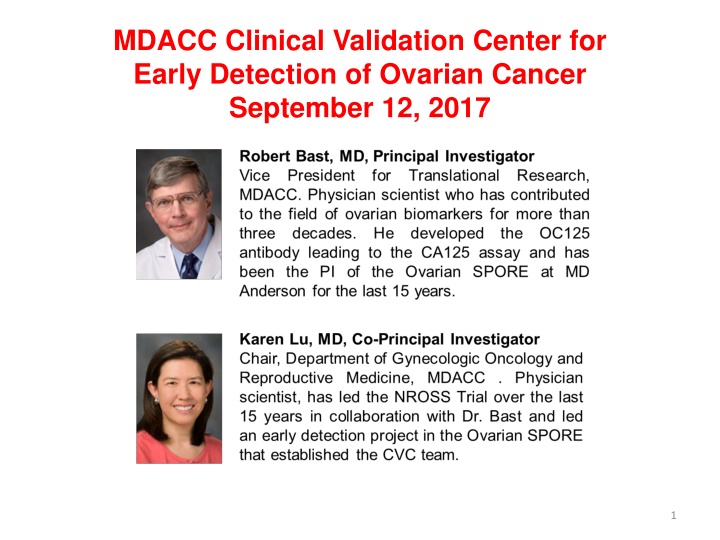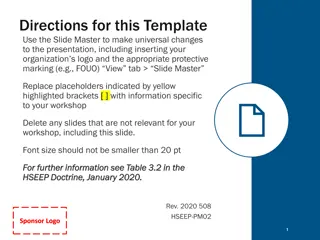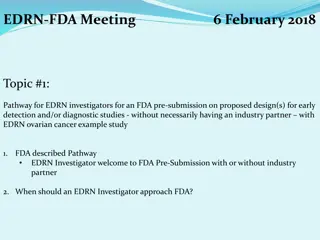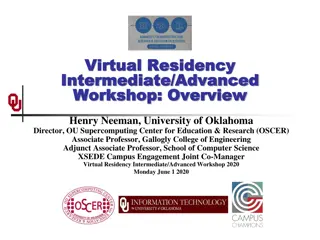
Innovative Strategies for Early Detection of Ovarian Cancer
Explore the collaborative efforts at MD Anderson Cancer Center aimed at revolutionizing early detection and treatment of ovarian cancer. Learn about the significance of preclinical disease detection, screening requirements, and two-stage screening strategies for improved patient outcomes.
Uploaded on | 2 Views
Download Presentation

Please find below an Image/Link to download the presentation.
The content on the website is provided AS IS for your information and personal use only. It may not be sold, licensed, or shared on other websites without obtaining consent from the author. If you encounter any issues during the download, it is possible that the publisher has removed the file from their server.
You are allowed to download the files provided on this website for personal or commercial use, subject to the condition that they are used lawfully. All files are the property of their respective owners.
The content on the website is provided AS IS for your information and personal use only. It may not be sold, licensed, or shared on other websites without obtaining consent from the author.
E N D
Presentation Transcript
MD Anderson Cancer Center MDACC Clinical Validation Center for Early Detection of Ovarian Cancer September 12, 2017 ion Center for Early Detection of Ovarian Cancer 1
MDACC EDRN Co-Investigators Deepak Bedi, MD Professor of Radiology and Director of Ultrasound at MDACC, will review all transvaginal sonograms from patients on the CVC trial at MDACC Women s Hospital in Houston and will work with imagers at all of the NROSS sites to assure uniform quality and standards. Beverly Handy, MD Associate Professor of Pathology at MDACC and a board-certified clinical pathologist with 16 years of experience in developing and using biomarker assays. Will supervise the analysis of serum samples provided to the MDACC Clinical Pathology Laboratory where biomarkers for the entire NROSS study are analyzed at a single site. Steven Skates, PhD Associate Massachusetts General Hospital and Harvard Medical School, with more than 25 years of experience in biostatistics, will develop the ROCA2 and ROCA3 algorithms that will be required for the NROSS2 and NROSS3 EDRN-CVC trials. Jinsong Liu, MD, PhD Professor of Pathology at MDACC, and a gynecologic pathologist, will review slides from all surgical cases prompted by the ROCA2 and ROCA3 algorithms in the NROSS2 and NROSS3 trials. Dr. Liu will work with Mr. Celestino to maintain the tumor bank and provide quality assurance for diagnosis of stored samples. Professor of Biostatistics at The screening sites include: 1) MDACC, Houston, TX Therese Bevers, MD, PI 2) Women s Hospital, Houston, TX Leroy Leeds, MD PI 3) UT Southwestern, Dallas TX Matthew Carlson, MD, PI 4) Women s and Infants Hospital, Providence, RI Cara Mathews, MD, PI 5) John Stoddard Hospital, Des Moines, IW Stephen Elg, M.D., PI 6) Carol G. Simon Cancer Center, Morristown, NJ Daniel Tobias, MD, PI 7) University of Miami, Miami, FL - Michael Slomowitz, MD, PI 8) University of Oklahoma, Oklahoma City, OK Laura Holman, MD, PI 9) University of Rochester, Rochester, NY- Richard Moore, MD, PI 10) University of Texas Austin, Austin, TX Yvette Brown, MD, PI 11) University of Texas San Antonio, San Antonio, TX Georgia McCann, MD, PI 2
Introduction/Background Ovarian Cancer Limited to the Ovaries (Stage I) can be Cured in up to 90% of Patients with Currently Available Therapy Disease that has Spread from the Pelvis (Stage III-IV) can be Cured in only 20% or Less Only 20% of Ovarian Cancers are Currently Diagnosed in Stage I Detection of Preclinical Disease at an Earlier Stage Could Improve Survival by 10-30% 3
Requirements For Screening Postmenopausal Prevalence: 1:2,500 High Sensitivity: 75% Very High Specificity: 99.6% Positive Predictive Value: 10% 4
Two Stage Screening Strategies Used alone, Neither CA125 nor Transvaginal Sonography (TVS) has Adequate Specificity Ovarian Cancer is Associated with rising CA125 and Benign Disease is not Very High Specificity and Sensitivity can be attained when rising CA125 is used to trigger TVS in a Two Stage Strategy The Risk of Ovarian Cancer (ROC) Algorithm relies on each Woman s own Baseline to determine whether there has been a significant increase 5
NROSS Screening Protocol ROC Algorithm Annual CA 125
NROSS Screening Protocol NORMAL ROC Algorithm Annual CA 125
NROSS Screening Protocol NORMAL ROC Algorithm Annual CA 125 ABNORMAL USS SURGERY
NROSS Screening Protocol NORMAL Repeat CA 125 ROC Algorithm Annual CA 125 INTERMED ABNORMAL USS SURGERY
Stage IC high grade invasive cancer Stage IIB high grade invasive cancer Stage IC high grade invasive cancer
Early Detection of Ovarian Cancer: Background Two Stage Screening Strategies based on the Risk of Ovarian Cancer Algorithm (ROCA) - The Normal Risk Ovarian Cancer Screening Study (NROSS) conducted by the MD Anderson SPORE in Ovarian Cancer screened 5,729 women over 17 years performing 19 operations to detect 12 ovarian cancers with 9 in stage I or II - >200,000 women and showed a decrease in mortality of 20% (P<0.021) in non-prevalent cases of ovarian cancer, albeit with wide confidence limits The United Kingdom Clinical Trial of Ovarian Cancer Screening (UKCTOCS) enrolled - Both trials required no more than 3-4 operations for each case of ovarian cancer detected CA125 is not optimal for an initial stage in that 20% of ovarian cancers do not express the biomarker. - From 110 candidates, HE4 and CA72.4 detected 16% of cases missed by CA125, but did not improve lead time. - Anti-TP53 auto-antibodies detected 16% of cases missed by CA125 and titers were elevated 27 months before clinical detection of disease in CA125 negative cases and 7 months before CA125 in cases detected by the ROCA. A Multi-Marker ROCA is being developed to achieve greater sensitivity than CA125 alone.
TP53 autoantibodies levels and CA125 values in serum samples from the UKCTOCS screening trial Yang et. al., Clinical Cancer Research (June 2017)
TP53 autoantibody has lead time over CA125 (longitudinal analysis) Early stage cases Late stage cases Yang et. al., Clinical Cancer Research (June 2017)
Longitudinal analysis of CA125 and TP53 autoantibodies titers in the UKCTOCS study Yang et. al., Clinical Cancer Research (June 2017)
MDACC EDRN Specific Aims Aim 1: To conduct an NROSS2 screening trial to determine the specificity and positive predictive value for a multi-biomarker ROCA potentially including CA125, HE4, CA72.4 and anti-TP53 autoantibodies in a two stage strategy for early detection of ovarian cancer in postmenopausal women at average risk for the disease. We will test the hypothesis that rising values of multiple biomarkers will prompt the referral of no more than 2% of women for TVS and that the overall strategy will achieve a positive predictive value >10%. Aim 2: To maintain and share a serum and plasma bank to facilitate evaluation of novel biomarkers for early detection. Our goal will be to provide serum, plasma and tissue to multiple sites in the EDRN to identify biomarkers that complement CA125 and provide lead time over CA125. Aim 3: To collaborate with other Centers in the EDRN Biomarker Development Laboratories to develop a next generation ROCA3 algorithm and an NROSS3 clinical trial for early detection. Our goal will be to develop the ROCA 3 algorithm and initiate an NROSS3 trial before completion of the project period. 15
ID01-022 Low Risk Ovarian Study New Participants Accrued March, 2016 - August, 2017 Total: 435 500 450 435 403 400 352 350 300 288 266 250 246 236 224 217 200 200 191 181 154 150 135 114 100 88 50 40 17 0 Mar,16 Apr, 16 May, 16 Jun, 16 Jul, 16 Aug, 16 Sept, 16 Oct, 16 Nov, 16 Dec, 16 Jan, 17 Feb, 17 Mar, 17 Apr, 17 May, 17 Jun, 17 New Participants Accrued Jul, 17 Aug, 17
ID01-022 Low Risk Ovarian Study Number of Specimens Collected 3,908 March, 2016 - August, 2017 4500 4000 3908 3679 3500 3467 3181 3000 2955 2775 2500 2505 2269 2099 2000 1876 1639 1500 1443 1192 1000 981 779 593 500 358 178 0 Mar, 16 Apr, 16 May, Jun, 16 Jul, 16 Aug, 16 Sept, Oct, 16 Nov, 16 Dec, 16 Jan, 17 Feb, 17 Mar, 17 Apr, 17 May, # Specimens Collected Jun, 17 Jul, 17 Aug, 17 16 16 17
Potential Area(s) Of Collaboration With Other Members Of The EDRN OVARIAN CANCER Blood only Blood/ Frozen tissue Frozen tissue only Median Age Serous Carcinoma Clear Cell Carcinoma Endometrioi d Adenocarcin oma 23 9 14 2 Mixed Other STAGE 1 STAGE 2 STAGE 3 STAGE 4 31 20 116 35 202 61 29 167 43 300 31 10 120 27 188 54 64 61 59 26 28 293 85 25 9 10 5 10 13 52 8 33 3 32 10 Race and Ethnicity Overall for Ovarian Cancer Patients Asian Black Hispanic White Unk/Other Total Cases 39 41 91 514 5 690 BENIGN DISEASE Specimen Blood/ Frozen tissue 425 Age Race TOTAL Blood only Frozen tissue only 243 Median Age Asian Black Hispanic White Unk TOTAL 980 312 56 43 100 125 708 4 18
MDACC EDRN Specific Aim 2 UNTREATED OVARIAN CANCER TREATED OVARIAN CANCER Stage 1 Stage 2 Stage 3 Stage 4 Stage 1 Stage 2 Stage 3 Stage 4 24 6 29 12 4 5 51 12 Early Stage = 30 Late Stage = 41 Early Stage = 9 Late Stage = 63 Tumor tissue Serum/Plasm a Tumor tissue Serum/Plasm a Tumor tissue Serum/Plasm a Tumor tissue Serum/Plasma 18 25 34 28 5 9 42 60 Benign Cases Total = 77 Tumor tissue Serum/Plasm a 40 49 19
Circulating Autoantibody Biomarkers for Early Detection of Ovarian Cancer This TEAM project proposes a validation study from existing candidate biomarkers by EDRN investigators Robert Bast, Karen Lu (MDACC) Karen Anderson (ASU) Charles Drescher (FHCRC) Steven Skates (MGH) Zhen Zhang (JHMI)
Biospecimen Sources: Samples obtained at diagnosis and matched controls (Bast, Drescher) Longitudinal preclinical samples from local ovarian cancer screening trials (NROSS, Ovarian Cancer Early Detection Program (OCEDP) Preclinical samples from large cohort studies (WHI, PLCO, UKCTOCS) Biomarker Candidates: Anderson (ASU) 16 candidates Drescher (FHCRC) 5 candidates currently with 25 total expected by year 2 Bast (MDACC) 4 candidates currently with 10 total expected by years 2-3. 1) 2) 3)
Approach: Develop MagPlex Luminex assays for promising autoantibodies Evaluate specificity of candidate biomarkers in the EDRN reference set; Evaluate candidates in the combined MDACC/FHCRC sample set Rank candidates based on their sensitivity at 95% and 98% specificity in the combined MDACC/FHCRC sample set at the time of conventional diagnosis Develop a biomarker panel based on the statistical analysis of the MDACC/FHCRC sample sets Perform subgroup analysis on high- and low-grade serous, clear cell, mucinous and endometrioid cancers and borderline ovarian tumors
Approach Continued Evaluate performance of top markers and biomarker panel in pre-clinical samples from participants in local ovarian cancer screening trials as prelude to requesting samples for large population-based cohort studies or ovarian cancer screening trials Develop a standard multi-plex platform assay with Zhen Zhang at JHMI Rank candidates based on assay performance in 100 serum biospecimens from ovarian cancer cases in the WHI observational study diagnosed within one year of second sample and in samples from controls, or samples obtained at diagnosis from EDRN groups Validate candidates based on assay performance with 1500 serial preclinical samples and 5-fold controls from the UKCTOCS
Candidates for Early Detection of Ovarian Cancer Will be Considered Validated If: Clinical sensitivity is achieved (5% or greater) at 98% specificity at least 1 year prior to clinical detection OR There is improved performance of a combined biomarker panel Algorithm Steve Skates will develop a ROCA-like algorithm with the validated antibodies and CA125 and other EDRN biomarkers to be validated
















